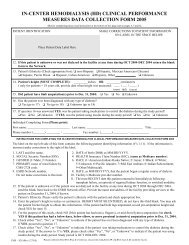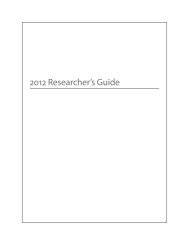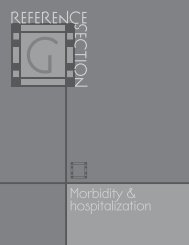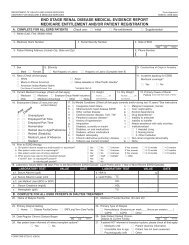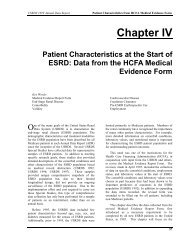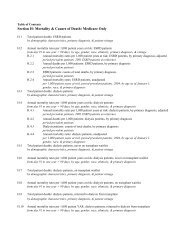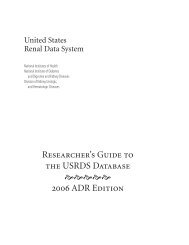2009 ADR v2 Atlas of ESRD - United States Renal Data System
2009 ADR v2 Atlas of ESRD - United States Renal Data System
2009 ADR v2 Atlas of ESRD - United States Renal Data System
You also want an ePaper? Increase the reach of your titles
YUMPU automatically turns print PDFs into web optimized ePapers that Google loves.
5<br />
App A<br />
pg 384<br />
than in a group whose patients are each followed for up to a full<br />
year. Rates per unit <strong>of</strong> follow-up time at risk, in contrast, count only<br />
the actual time that a patient is at risk for the event.<br />
METHODS FOR ADJUSTING RATES<br />
Because each cohort contains a different patient mix, unadjusted<br />
event rates may not be comparable across cohorts. Adjusted analyses<br />
make results comparable by reporting rates that would have arisen<br />
had each cohort contained patients with the same distribution <strong>of</strong><br />
confounders — such as age, gender, race, and primary diagnosis — as<br />
the reference population.<br />
direct adjustment<br />
There are several rate adjustment methods, but only the direct<br />
method allows rates to be compared (Pickle LW, White AA). Here<br />
the adjusted rate is derived by applying the observed category-specific<br />
rates to a single standard population, i.e. the rate is a weighted average<br />
<strong>of</strong> the observed category-specific rates, using as weights the proportion<br />
<strong>of</strong> each category in the reference population. Categories are<br />
defined by the adjusting variables. For example, if a rate is adjusted<br />
for race and gender and there are three race groups (white, African<br />
American, and other) and two gender groups, there are six categories:<br />
white males, white females, African American males, African<br />
American females, males <strong>of</strong> other races, and females <strong>of</strong> other races.<br />
Suppose we try to compare state-level incident rates in 2001<br />
after removing the difference caused by race. To do this, we need<br />
to calculate the adjusted incident rate, adjusted for race, for each<br />
state. Because racial distributions in each state are quite different,<br />
we use as reference the national population — here, the population<br />
at the end <strong>of</strong> 2001 — with five race groups (white, African American,<br />
Native American, Asian/Pacific Islander, and other).<br />
Assuming the incident rate <strong>of</strong> state A in 2001 is 173 per million<br />
population, and the race-specific rates and national populations are<br />
as shown in the following table, the adjusted incident rate <strong>of</strong> state<br />
A with the national population as reference is (153 x 75.1%) + (250 x<br />
12.3%) + (303 x 0.9%) + (174 x 3.6%) + (220 x 8%) = 158.73 per million<br />
population. This means that if state A had the same racial distribution<br />
as the entire country, its incident rate would be 158.73 instead<br />
<strong>of</strong> 173. If state B had an adjusted incident rate <strong>of</strong> 205, we could say<br />
that state B had a higher incident rate than state A if they both had<br />
the same racial distribution as the whole country.<br />
Incident rate National<br />
<strong>of</strong> State A Population (%)<br />
White 153 75.1<br />
African American 250 12.3<br />
Native American 303 0.9<br />
Asian/Pacific Islander 174 3.6<br />
Other 220 8.0<br />
This method is used to produce some adjusted incident and prevalent<br />
rates in Chapters Two and Three and in Reference Sections A<br />
and B, as well as in the model-based adjustment method.<br />
model-based adjustment<br />
Under some circumstances there are disadvantages to the direct<br />
adjustment method. Suppose we are calculating mortality rates for<br />
a set <strong>of</strong> groups, and adjusting for potential confounding variables.<br />
If one category in a group has only a few patients or deaths, its estimated<br />
mortality rate will be unstable, likely making the adjusted rate<br />
unstable as well. In addition, if one includes category no patients,<br />
the method is not valid for calculating an adjusted mortality rate for<br />
the group. An attractive alternative is a model-based approach, in<br />
which we find a good model to calculate category-specific estimated<br />
rates for each group and then calculate direct adjusted rates using<br />
these estimates with a given reference population. This method can<br />
also be extended to adjustments with continuous adjusting variables<br />
(Liu et al., 2006). There is, unfortunately, no straightforward<br />
way here to calculate standard errors <strong>of</strong> the adjusted rates for some<br />
models; the bootstrap approach works well, but is time consuming.<br />
In this <strong>ADR</strong> we use model-based adjustments to calculate adjusted<br />
mortality rates; adjusted survival probabilities based on the Cox<br />
regression model; adjusted hospitalization rates and state-level<br />
adjusted incident and prevalent rates using the Poisson model;<br />
adjusted HSA-level incident and prevalent rates based on the Bayesian<br />
spatial hierarchical model, and some other rates, described in<br />
the text on the individual figures.<br />
SURVIVAL PROBABILITIES & MORTALITY RATES<br />
unadjusted survival probabilities<br />
In this <strong>ADR</strong>, unadjusted survival probabilities are calculated using<br />
the Kaplan-Meier method, and corresponding standard errors are<br />
calculated with Greenwood’s formula (Kalbfleisch JD, Prentice RL).<br />
Survival probabilities in Reference Section I are expressed as percentages<br />
from 0 to 100.<br />
adjusted survival probabilities<br />
Adjusted survival probabilities are reported in Reference Sections G<br />
and I, with age, gender, race, and primary diagnosis used as adjusting<br />
risk factors. The model-based adjustment method is used with<br />
survival probabilities predicted from the Cox regression model (Kalbfleisch<br />
JD, Prentice RL). This process yields estimates <strong>of</strong> probabilities<br />
that would have arisen in each year if the patients had had the<br />
same attributes as the reference population. Since the probabilities<br />
in each table are adjusted to the same reference set <strong>of</strong> patient attributes,<br />
any remaining differences among cohorts and years are due<br />
to factors other than age, gender, race, and primary diagnosis. The<br />
adjusted mortality rates for incident cohorts in Reference Section<br />
H are calculated using similar methods.<br />
GENERALIZED LINEAR MODELS<br />
generalized linear mixed model for mortality rates<br />
We use the generalized linear mixed model with log link and Poisson<br />
distribution to calculate mortality and first transplant rates for<br />
prevalent patients. While rates are reported for a year, data from the<br />
previous two years with different weights are also used to improve<br />
the stability <strong>of</strong> the estimates. The generalized linear mixed model<br />
is used as well for SMR calculations, described later in this section.<br />
The generalized linear mixed model, which considers both fixed<br />
and random effects, is implemented using the SAS macro GLIMMIX.<br />
The rates for the intersections <strong>of</strong> age, gender, race, and diagnosis<br />
are estimated using the log linear equation Log (rate) = (fixed<br />
effects) + (random effect). Fixed effects include year, age, gender,<br />
race, and primary diagnosis, and all two-way interactions among<br />
age, gender, race, and primary diagnosis. Assumed to be independently<br />
and identically distributed with a normal distribution, the<br />
random effect is the four-way interaction <strong>of</strong> age, gender, race, and<br />
primary diagnosis. Age is used as a categorical variable in main<br />
effect and four-way interactions, and as a continuous variable in<br />
the two-way interactions.<br />
For tables with mortality rates for both intersecting and marginal<br />
groups we have used a single model to calculate all rates in




